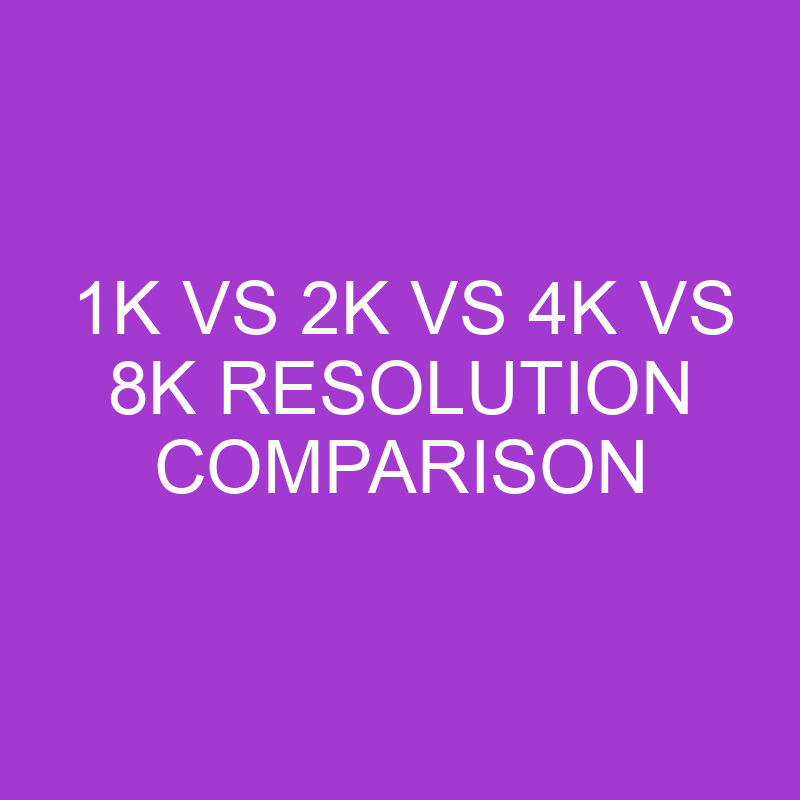Decoding Display Resolutions: 1K, 2K, 4K, and 8K
In the realm of visual technology, the race for higher resolutions has led to the emergence of terms like 1K, 2K, 4K, and even 8K. These designations, often associated with display quality, can be both intriguing and perplexing for consumers. In this comprehensive exploration, we’ll unravel the intricacies of 1K, 2K, 4K, and 8K resolutions, exploring their origins, characteristics, and applications in the ever-evolving landscape of digital displays.
Post Contents
1K Resolution:
Overview:
1K resolution is a term commonly used to describe displays with approximately 1,000 horizontal pixels. This resolution is often associated with early digital displays and the transition from standard definition to higher clarity.
Key Features:
- Resolution: Around 1,000 horizontal pixels (e.g., 1024 x 768 pixels).
- Aspect Ratio: Typically maintains the 4:3 aspect ratio.
- Applications: Found in early computer monitors, digital cameras, and entry-level displays.
Pros and Cons:
- Pros: Improved clarity over standard definition, cost-effective.
- Cons: Limited compared to modern standards, becoming less prevalent.
2K Resolution:
Overview:
The term 2K resolution is somewhat ambiguous, as it can refer to resolutions around 2,000 pixels horizontally or approximately 2,048 pixels. It gained popularity in the digital cinema industry as a step up from traditional HD.
Key Features:
- Resolution: Around 2,000 horizontal pixels (e.g., 2048 x 1080 pixels).
- Aspect Ratio: Often maintains the widescreen 16:9 aspect ratio.
- Applications: Commonly used in digital cinema, some gaming monitors, and high-end smartphones.
Pros and Cons:
- Pros: Improved visual quality, widely adopted in professional video production.
- Cons: Ambiguous term, not a standard consumer resolution.
4K Resolution:
Overview:
4K, also known as Ultra High Definition (UHD), represents a substantial leap in visual clarity. It has become the standard for premium TVs, gaming monitors, and professional video production.
Key Features:
- Resolution: 4K has a resolution of 3840 x 2160 pixels (2160p) or 4096 x 2160 pixels in the film industry.
- Aspect Ratio: Maintains the 16:9 widescreen aspect ratio.
- Applications: Widely used in TVs, gaming monitors, digital cameras, and video production.
Pros and Cons:
- Pros: Exceptional visual fidelity, widespread adoption, ideal for larger screens.
- Cons: Demands higher processing power, premium price tag.
8K Resolution:
Overview:
8K represents the pinnacle of current consumer display resolutions, offering an unprecedented level of detail. It is often associated with ultra-large TVs and professional video editing.
Key Features:
- Resolution: 8K has a resolution of 7680 x 4320 pixels.
- Aspect Ratio: Maintains the 16:9 widescreen aspect ratio.
- Applications: Found in ultra-large TVs, high-end gaming monitors, and professional video editing setups.
Pros and Cons:
- Pros: Unparalleled visual fidelity, ideal for cinematic experiences and professional applications.
- Cons: Requires substantial hardware capabilities, limited native content, premium pricing.
The Evolution of Resolution:
Understanding the evolution from 1K to 8K resolutions showcases the relentless pursuit of visual perfection in the digital age. As consumers embrace larger screens and demand richer visual experiences, higher resolutions continue to redefine the standards of clarity and detail. Whether it’s the practicality of 4K for everyday entertainment or the cutting-edge capabilities of 8K for immersive experiences, the choice between these resolutions depends on factors like display size, intended use, and budget considerations.
Conclusion:
The journey from 1K to 8K resolutions reflects the dynamic landscape of visual technology. While 1K and 2K resolutions may seem like relics of the past, their contributions paved the way for the immersive experiences offered by 4K and 8K displays. As technology advances, the pursuit of higher resolutions persists, promising even more breathtaking visuals and pushing the boundaries of what is perceptually possible. As consumers navigate the array of display options, understanding the nuances of each resolution empowers informed choices tailored to their preferences and viewing habits.

